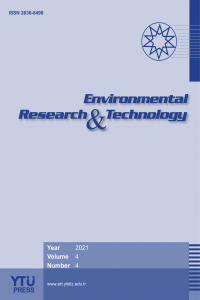Abstract
Supporting Institution
Van yüzüncü yııl üniveristesi
Project Number
FBA-2018-6979
References
- A. F. Streit, G. C. Collazzo, S. P. Druzian, R. S. Verdi, E. L. Foletto, L. F. Oliveira, and G. L. Dotto, “Adsorption of ibuprofen, ketoprofen, and paracetamol onto activated carbon prepared from effluent treatment plant sludge of the beverage industry,” Chemosphere, Vol.262, pp.128322, 2021.
- T. Alvarino, S. Suarez, J.M. Lema, and F. Omil, “Understanding the removal mechanisms of PPCPs and the influence of main technological parameters in anaerobic UASB and aerobic CAS reactors,” Journal of Hazardous Materials, Vol.278, pp.506-513, 2014.
An investigation based on removal of ibuprofen and its transformation products by a batch activated sludge process: A kinetic study
Abstract
Ibuprofen metabolites can form in humans as a result of metabolic activities or can be produced by microorganisms in wastewater treatment plants and receiving environments, which increases their likelihood of being present in the environment. In this study, various experiments were conducted to determine the removal degree for ibuprofen, ibuprofen carboxylic acid (IBU-CBX), and 2-hydroxylated ibuprofen (IBU-2-OH) metabolites with an activated sludge reactor. Furthermore, the pseudo-first-order biodegradation rate constant (kbiol) (17.76 L/g SS day) was calculated to determine the decomposition degree of ibuprofen in the batch activated sludge system. The effects of different ibuprofen concentrations (8.2, 5.6, 3.2, 1.51 mg/L) at constant biomass concentration (3 g/L) on the biodegradation mechanism were investigated. In addition, IBU-2-OH and IBU-CBX were tested in a batch activated sludge reactor with a volume of 2 L individually at 100 μg/L with activated sludge containing 3 g/L biomass. It was observed that ibuprofen had a removal efficiency of more than 90%. IBU-CBX and IBU-2-OH were removed at approximately 27-91% and 18-82%, respectively. In abiotic conditions, the removal of ibuprofen was found to be 7.07%. It was confirmed that the removal of ibuprofen largely depended on biological degradation. This study enabled us to know which metabolites are involved in the biodegradation process of ibuprofen in batch experiments with the activated sludge process.
Keywords
Project Number
FBA-2018-6979
References
- A. F. Streit, G. C. Collazzo, S. P. Druzian, R. S. Verdi, E. L. Foletto, L. F. Oliveira, and G. L. Dotto, “Adsorption of ibuprofen, ketoprofen, and paracetamol onto activated carbon prepared from effluent treatment plant sludge of the beverage industry,” Chemosphere, Vol.262, pp.128322, 2021.
- T. Alvarino, S. Suarez, J.M. Lema, and F. Omil, “Understanding the removal mechanisms of PPCPs and the influence of main technological parameters in anaerobic UASB and aerobic CAS reactors,” Journal of Hazardous Materials, Vol.278, pp.506-513, 2014.
Details
| Primary Language | English |
|---|---|
| Subjects | Environmental Engineering |
| Journal Section | Research Articles |
| Authors | |
| Project Number | FBA-2018-6979 |
| Early Pub Date | December 31, 2021 |
| Publication Date | December 31, 2021 |
| Submission Date | June 3, 2021 |
| Acceptance Date | October 25, 2021 |
| Published in Issue | Year 2021 Volume: 4 Issue: 4 |


